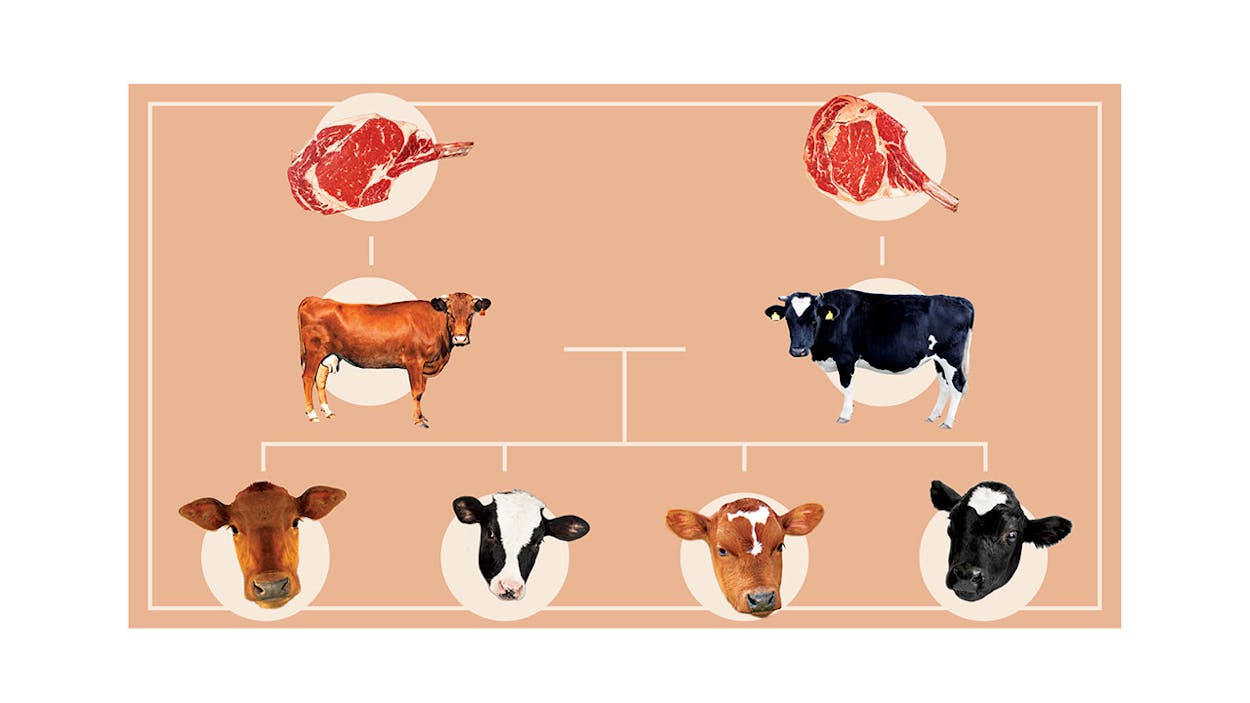On a cool morning in early October, a 2,400-pound black bull named Alpha struts around a pasture east of the Panhandle town of Canyon as if he’s royalty. His parentage, though, is a mystery. Alpha is quite literally the son of a steak. Cloned in 2012 from a prime carcass procured from a slaughterhouse by West Texas A&M University animal science professor Ty Lawrence, Alpha is the first step in a process that could change the beef industry from pasture to plate.
At the moment, the project is small-scale. Alpha was mated with three cows cloned from a different prime carcass, and in mid-2015 they birthed thirteen calves—nine bulls and four heifers. Seven of those were slaughtered this past May, and the results were impressive: the clones’ descendants were considerably larger than your typical cow. More to the point, they produced ribeyes that were 18 percent bigger than average and exceedingly well marbled.
It’s too soon to know if the results will be consistent enough for commercial application. John Sharp, the chancellor of the A&M System, is optimistic. “I think they’re on their way to doing something that’s really what the land-grant mission is all about: improving people’s lives,” says Sharp, who has a picture of Alpha hanging in his office. Sharp has served some of the meat to friends, all of whom were impressed by the taste and tenderness.
Most American beef that is sold to individual consumers comes in three grades, of which prime is the most sought after. The beef industry wants to produce cattle that yield as many prime cuts as possible, but that’s never been easy to do. Lawrence’s research turns the process on its head. It starts with the end product that everyone wants—a prime steak—and basically reverse engineers the breeding process. When Lawrence spotted the carcass that produced Alpha, he didn’t have anything in particular in mind. He routinely conducts research in slaughterhouses to evaluate meat quality and on that day was particularly impressed when he noticed a couple of carcasses that he regarded as “unique for superior quality and yield.” That got him thinking, and he called his department head, Dean Hawkins, and suggested they collect some cells and clone a steer. As the two men talked, they began to think bigger: What if they cloned a heifer as well as a bull? “If we made these two animals, what would the offspring look like?” Lawrence wondered. After selecting the carcasses, they contacted ViaGen, a Cedar Park biotech company that holds a patent on the cattle-cloning process.
Cloned beef is not genetically modified; Alpha’s DNA was copied, unaltered, from a slaughtered animal. “They’re identical twins separated by time,” Lawrence says. If you didn’t know Alpha was a clone, you would have no way to tell. In fact, to avoid any confusion, Alpha’s brand is on his left shoulder, rather than his hip, where most WTAMU cattle are branded.
The Food and Drug Administration has declared cloned meat safe to eat, but many people are wary of the process. So Lawrence and his colleagues decided that Alpha and other clones will never enter the food chain. Alpha’s progeny, however, aren’t clones—they just carry their cloned parents’ superior genetics.
As we’re looking at Alpha in his small grass paddock, rancher Jason Abraham lands his helicopter in an adjacent pasture. Much of the cloning process was done at a lab on his ranch in Canadian. These days, the lab mostly clones horses and deer, but he donated its services because of the potential upside for the cattle industry and the students at WTAMU. “This is just getting started,” he says. “This can lead to research in other things, like curing diseases.”
One of the unexpected benefits of the project is that Alpha’s offspring seem to be more resistant to illnesses such as bovine respiratory disease. “These cows don’t get sick,” says veterinarian Gregg Veneklasen, a member of the research team. The group is still studying why cloning seems to strengthen bovine immunity, but the implications are significant; fighting illness is one of the beef industry’s biggest expenses. The cloned cattle also reach maturity faster, which means that over their lifetimes they eat less, use less water, and produce less methane—reducing the carbon footprint of cattle production. Whether those potential benefits can cover the costs of cloning depends on whether clones can be produced in commercial quantities and generate economies of scale.
“This is still a research project,” Lawrence says. “We’re still asking questions.” And having some pretty good dinners.








